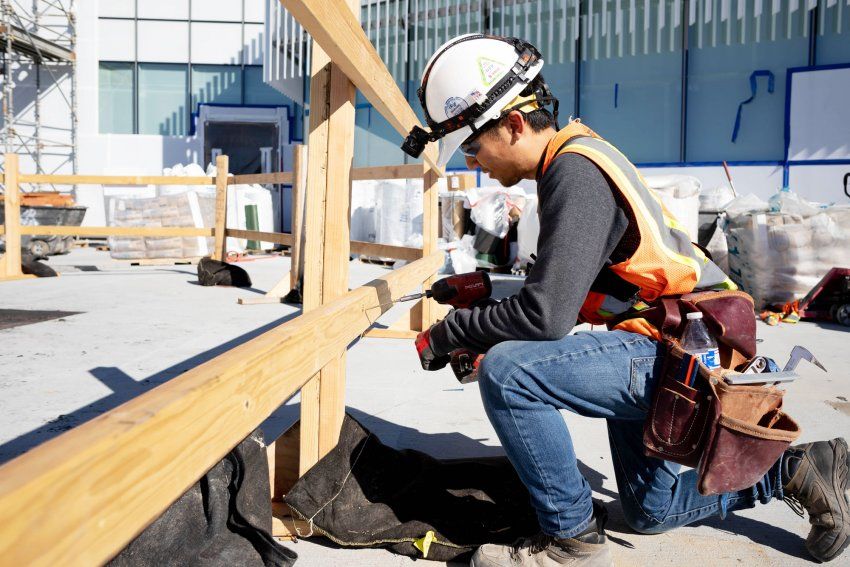Groundbreaking Community Workforce Agreement for UCSF Parnassus Heights Project is Boon for Local Jobs, Economy
$3 Billion Project Expected to Create 1,000 Construction Jobs

Stanly Chen, a local apprentice carpenter, works at the Mission Bay campus in February 2020. A new UCSF workforce agreement is expected to create 1,000 new construction jobs for its Parnassus Heights hospital build. Photo by Susan Merrell
UC San Francisco, the San Francisco Building and Construction Trades Council (BCTC), and Herrero Boldt Webcor (HBW) announced Sunday a Community Workforce Agreement (CWA) that will promote collaboration between the University, labor unions and construction firms during the construction of the new hospital at UCSF Helen Diller Medical Center at Parnassus Heights.
To ensure the highest quality, safety, and efficiency in construction, BCTC, the local body of North America’s Building Trades Unions (NABTU), will enter into the agreement on behalf of 30,000 local skilled workers in 22 trade unions.
The pact, the first of its kind for the University of California system, is a formal agreement between BCTC and HBW, the general contractor hired by UCSF. It ensures that the $3 billion building project will employ a union workforce with strong representation of local labor. In addition, the agreement has special provisions that provide opportunities for apprentices in the trades and military veterans to be well represented in the 1,000 projected jobs created by the Parnassus Heights project over its 10-year timeline, from start to finish.
In its support of robust job creation in San Francisco to help reverse the record economic downturn during the COVID pandemic, the new CWA builds upon and complements the Memorandum of Understanding between UCSF and the City and County of San Francisco. In the MOU, agreed upon in principle on Jan. 4, UCSF’s leadership role as an “anchor institution” in San Francisco is reflected in its commitment to partner with CityBuild, an initiative of the City’s Office of Economic and Workforce Development, to achieve a 30 percent local hire target for all construction workers on the Parnassus Heights project.
The CWA lays out a partnership among all parties, including any subcontractors, to set wages, resolve disputes, and address grievances in a manner that honors all collective bargaining agreements, in order to avoid strikes, work stoppages and lockouts for the duration of the decade-long project. By doing so, the CWA ensures that Parnassus Heights jobs will not only pay the best wages, but also will be a steady and reliable source of income for San Francisco workers and their families.
“CWAs are a transparent, proven, and time-tested way to attract and retain the most skilled workers for complex construction projects,” said Rudy Gonzalez, BCTC secretary-treasurer. “Studies have shown that when workers are paid a living wage, they inject those dollars directly back into the local economy. This agreement builds a sturdy bridge between local hiring halls and contractors to support our City’s working people, including apprentices, journey workers, and military veterans, in putting food on the table for their families. It couldn’t have come at a more crucial moment in our City’s history.”
UCSF Chancellor Sam Hawgood, MBBS, hailed the new agreement as a “win-win” for UCSF and the local labor force. “This unique CWA was carefully crafted through months of collaboration between UCSF, the Trades Council, and HBW, and it offers a strong contribution to San Francisco’s economic recovery at a particularly urgent time,” Hawgood said. “The past year has revealed the vulnerability of the region’s hospital capacity. By employing our region’s most skilled workers, we can together focus on building the critical health care infrastructure San Francisco needs today.”
David Thomack, executive member for Herrero Boldt Webcor and group president for The Boldt Company, said, “The Herrero Boldt Webcor team is excited to be partnering with BCTC, UCSF, Bay Area trade contractors and the exceptional men and women of the local trade unions. Through demonstrated collaboration and innovation, this landmark healthcare construction project will create an extraordinary work experience for our frontline workers.”
San Francisco native Russell Au Yeung, a first-generation Chinese American and resident of the City’s Sunset District, is a journeyman electrician who applauds the CWA. He sees the agreement as a crucial first step toward steady, good-paying jobs for local union workers that will also ultimately benefit his neighborhood and the City at large. “Not only does this agreement create a new state-of-the-art medical facility for San Francisco families, but it is also creating good jobs for the community,” said Yeung, who serves as president of International Brotherhood of Electrical Workers Local 6.
The hospital at UCSF Helen Diller Medical Center at Parnassus Heights provides unique complex care in areas such as neurology and organ transplant that other area hospitals cannot provide, and operates one of only two Emergency Departments left serving San Francisco’s West Side. But the hospital’s aging facilities have not kept pace with its top-ranked clinical care, and each year capacity limitations force the University to turn away as many as 3,000 patients seeking advanced care. Most urgently, UCSF’s aging Moffitt Hospital does not meet state seismic code for inpatient facilities and must be replaced by 2030.
To ensure that the University, one of the world’s top-ranked academic medical centers, can continue serving the neighborhood and the sickest patients referred to UCSF from across the region, UCSF has planned a new hospital with modern facilities that will increase the Medical Center’s inpatient capacity and expand the Emergency Department to better serve the community and region.
UCSF has commissioned the architectural team of HDR and Herzog & de Meuron – the latter designed the de Young Museum in San Francisco’s Golden Gate Park – to design a new hospital that will seamlessly integrate with the surrounding Mount Sutro Open Space Reserve to promote an atmosphere of healing, in a construction process led by HBW. Pending approval by the University of California Board of Regents, construction of the new hospital will begin in 2023.